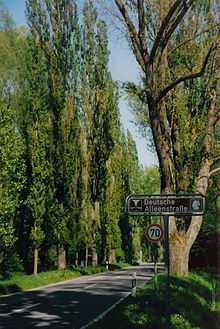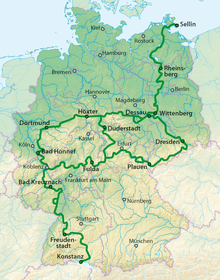German Avenue Road

The German Avenue Road (German: Deutsche Alleenstraße) is a tree-lined holiday route that runs the length of Germany from the Baltic Sea to Lake Constance.[1][2] About 2,900 kilometres long, it is Germany's longest scenic route. The project is supported by the "German Avenue Route Association" (Arbeitsgemeinschaft Deutsche Alleenstraße), whose members are the German Automobile Club ("ADAC"), the German Tourism Association, the German Forest Conservation Society and other institutions.[3] The forestry scientist, Hans Joachim Fröhlich, was its major proponent.
The aim of the Association is to preserve, protect and maintain avenues in Germany and to restore old avenues after they were destroyed in many places in recent years by road development and safety projects.[4] The Association says the Route connects "the East with West and North to South [and] is a symbol of German unity and common effort of the people of the old and new federal states for the protection of nature."[5]
Cobblestones still serve as pavement on many avenues in the former East German areas. An spokesman for the Route says the average speed is about 70 km/h (43 mph).[6]
The first segment of the German Avenue Road between Rügen Island and Reinsberg was inaugurated on May 3, 1993.[7]
History

The vision for the creation of the German Avenue Road began shortly after German unification:[8]
- Sept 11, 1989 – Opening of the Berlin Wall.
- March 10, 1990 – Reunification of Germany.
- Fall 1990 – ADAC, in its Motorworld magazine, issued an appeal to "Save the Avenues" of the former East Germany.
- Summer 1992 - Foundation established for "German Avenue Route" as a tourist facility and ideal connection between the old and new federal German states.
- May 3, 1993 - Opening of the first section between Sellin / Rügen and Rheinberg / Brandenburg (264 km)
- October 2, 1993 - Opening of the second part between Rheinberg / Brandenburg and Wittenberg / Saxony-Anhalt (168 km)
- September 29, 1994 - Opening of the 3rd section between Wittenberg / Brandenburg and Goslar / Lower (249 km)
- June 13, 1995 - Opening of the 4th section between Wittenberg / Saxony-Anhalt Dresden / Saxony to Plauen / Saxony (420 miles)
- June 26, 1996—Opening of the 5th Leg between Goslar and Plauen (low- Saxony, Saxony-Anhalt, Saxony, Thuringia, 510 miles)
- April 30, 1997—Opening of the 6th Leg between Meiningen (Thuringia) and Braubach am Rhein (Rhineland-Palatinate, 330 miles)
- May 6, 1998—Opening of the 7th Leg between Braubach (Rhineland-Palatinate) and Karlsruhe / Ettingen (Baden-Wuerttemberg, 290 km)
- May 25, 2000—Opening of the 8th Leg of Karlsruhe (Ettlingen) to the island Reichenau in Lake Constance (Baden-Wuerttemberg, 335 miles)
Route
Gallery
-

The German Avenue Road on the island of Rügen
-
Avenue on Rügen near Putbus
-
Ottenkreuz between Gau-Odernheim and Hillesheim
Literature
- Arbeitsgemeinschaft Deutsche Alleenstraße (Hrsg.): Deutsche Alleenstraße - von Rügen bis zum Bodensee. WKP-Verlag, Freilassing 2001 (2nd ed.)
- Baedeker Allianz: Reiseführer Deutschland. Ein As im Ärmel. Verlag Mair-Dumont. November 2009. p. 131f. ISBN 3-829-71186-9
- Thomas Billhardt, Günther Bellmann: Die Deutsche Alleenstraße. Zwischen Rügen und Rheinsberg. Ullstein, Berlin 1996. ISBN 3-550-06904-9
- Thomas Billhardt, Günther Bellmann: Die Deutsche Alleenstraße. Zwischen Rheinsberg und Wittenberg. Ullstein, Munich 2003 (5th ed.). ISBN 3-550-06887-5
- Ulf Böttcher, Wolfgang Hoffmann: Die deutsche Alleenstrasse - von der Insel Rügen bis zum Fläming. Mitteldeutscher Verlag, Halle 1995. ISBN 3-354-00857-1
References
- ↑ "Deutsche Alleenstraße". "(Original German:) Die Route von der Insel Rügen an der Ostsee bis zur Insel Reichenau im Bodensee umfasst rund 2.900 Straßenkilometer, fast alle eingerahmt von alten und wieder nachwachsenden Alleebäumen. (English translation:) The route, from the island of Rügen in the Baltic Sea to the island of Reichenau in Lake Constance, covers around 2,900 kilometers of roadway, almost all framed by old and renewable trees."
- ↑ Deutsche Alleenstraße – Wir über uns, accessed on 20 July 2010
- ↑ Deutsche Alleenstraße – Chronik: Gründungsmitglieder, accessed on 20 July 2010
- ↑ Christopher Cottrell. "Dangerous Lanes: German State Aims to Curb Tree Deaths". Der Spiegel. "Known for its majestically tree-lined boulevards, Brandenburg leaves its motorists little room for error. And now, with the number of tree-related deaths on the rise, the state Infrastructure Ministry called earlier this week for speed limits on the Brandenburg's most dangerous roads to be reduced to 70 kilometers per hour (43 mph). "In 2010, 192 people died on our streets -- 78 of whom were killed by trees," said Brandenburg's infrastructure minister, Jörg Vogelsänger."
- ↑ "Alleenschutz (English: Avenue Protection)". "(German)...das Ost mit West und Nord mit Süd verbindet... Die Deutsche Alleenstraße – Symbol der Deutschen Einheit und gemeinsamer Beitrag der Menschen in den alten und neuen Bundesländern zum Schutz der Natur"
- ↑ http://translate.google.com/translate?hl=en&sl=de&u=http://www.spiegel.de/auto/aktuell/deutsche-alleenstrasse-geniesser-lassen-sich-zeit-a-357737.html&prev=/search%3Fq%3DDeutscher%2BAlleenstrasse%2Btempolimit
- ↑ Chronicles of the German Avenue Road Project
- ↑ http://www.adac.de/_mmm/pdf/Alleenstrasse_Chronologie_18316.pdf

